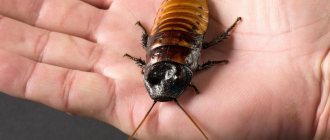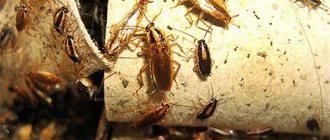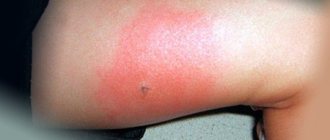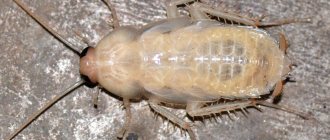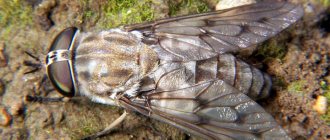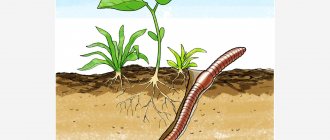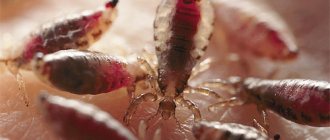It happens that you receive an order for processing, you ask what insects you have, and people say: “we don’t know, there are small bugs running around, similar to small ants, but definitely not ants, running around in the toilet, bathroom. The house is new, it’s not at all clear what kind of insects they are.”
With a high degree of probability, we can say that there are hay eaters in the client’s house. Hay eaters often appear in new buildings; they love block houses. This is because new homes have a fairly humid climate, and these bugs love humid conditions. Most likely they got into the house during construction, with building materials and remained in the apartment. Hay eaters feed on microscopic mold, fungi, and the remains of rotted leaves.
They do not bite, sting, or bother people or pets.
Synanthropic species of hay beetles
book louse and dust louse , with lice and lice they are distant relatives. You can distinguish the hay beetle from lice by its long antennae.
Hay eaters are relatively primitive insects, with small or severely atrophied wings or no wings.
Adults are 1-2 mm yellowish brown to black.
Since hay beetles develop with incomplete metamorphosis, the larvae are very similar to adult animals.
They are pale, sometimes transparent.
Insects similar to cockroaches
In addition to the above-mentioned insects, other types of household pests and ectoparasites that look similar to cockroaches live in apartments and private houses:
- Bed bug. A blood-sucking insect that parasitizes humans and warm-blooded animals. Reaches a length of 10 millimeters, has a yellow or brown color, a rounded flattened body. Leads a nocturnal lifestyle and is inactive. Egg clutches and colonies of adult individuals are located in hard-to-reach places in the apartment - ventilation shafts, corners of cabinets, cracks in walls, and so on;
- Woodlouse. A eukaryotic crustacean with an oval, convex body and 7 pairs of thoracic legs adapted for walking. Indoors it chooses warm and humid places to live, for example a bathroom, toilet, kitchen sink. Leads a nocturnal lifestyle, trying to waste plant and animal origin;
- Carpet beetle. Coleopteran insect reaching a length of 5-6 millimeters. It has a dense round body of brown or black color. It feeds on dead epithelium of animals and humans, leather and sofa fabrics, cardboard, wool, and rotten wood;
- Grinder beetle . A common household pest with a round body of dark shades without wings. Reaches a length of 10 millimeters. Leads a nocturnal lifestyle, gnawing holes in wood. In addition to cellulose, it eats organic matter;
- Silverfish. A wingless insect reaching a length of 2 centimeters. It has a flat body, tapering towards the back and covered with silvery scales. There are three thread-like processes in the tail area, and long whiskers extend from the head. Prefers a humid environment, consumes organic matter of plant origin;
- Earwig. The insect has a segmented, elongated, narrow body ending in the back with 2 horn-like stinger appendages. Reaches a length of 2.5 centimeters. Creates nests in closets, cellars, corridors.
Stages of development of the hay beetle.
- Between egg and adult, the larva goes through approximately 8 instars.
- Development occurs in the summer and lasts from 20 to 40 days
- At a constant temperature of 27C and humidity of about 65%, development lasts about 30 days, seven of which are at the egg stage.
- Six to eight generations may appear within a year.
- The lifespan of adult animals ranges from 10 to 12 weeks.
- Hay eaters need high air humidity from 65% to 95%
- They can live for a short time at humidity less than 60%; if the humidity drops, the mortality rate increases sharply.
- If you increase the humidity, the number of eggs laid by the female will increase; if you decrease it, the reverse process will occur.
Thus, creating dry conditions slows the growth of the hay beetle population, and may even stop growth completely.
Where do hay eaters live and reproduce?
You can find a hay eater in the apartment
- bath, toilet
- in the room, in the kitchen
- under carpets, in cupboards with cereals
- potted flowers
- bookshelves
- herbariums
- insect collections
- cereals, flour, seeds.
Hay eaters breed where there is high humidity. For example, in grains with a high water content, in moldy foods, products that are stored in conditions of high humidity, as well as in damp attics, basements, houses, under wooden floors on the first floors.
If hay beetle gets into food, it becomes unsuitable for food and you can get poisoned. Hay eaters also live in moldy rolls of straw and hay. If pets eat such hay, they can become infected with helminths.
Previously, in the old days, mattresses and pillows were stuffed with dry grass; if moisture gets into such a mattress, hay eaters may appear there.
It happens that mold appeared in the apartment, and then hayworms appeared, it’s all due to high humidity, this contributes to the rapid reproduction of hayworms. Hay beetles then begin to multiply rapidly and occupy new areas, ending up in cupboards and food products.
Some species of hay eaters feed on parasitic fungi; they can spread the spores of the eaten fungi along with their feces.
Types of cockroaches
Several species of cockroaches live at home, differing in appearance, but having similar habits and breeding cycles.
Red cockroach
The most famous and common insect in apartments in our country. In relation to him, the term “Prussian” is used at the philistine level. There is a myth that this species is alien and came to Russia from Prussia, a historical state whose territories are now part of Germany. In fact, the homeland of red cockroaches is southern Asia. From there the insect was brought to us and to Europe.
Red cockroaches reach a length of 15 millimeters, have a light brown tint with two dark stripes on the front chest, and wings. The narrow body of the insect ends in a wedge-shaped (males) or wide (females) abdomen.
Adults do not lay eggs, but carry them inside themselves. 1 month after fertilization, larvae are born, externally differing from full-fledged cockroaches only in size, lack of wings and color (darker).
Black beetle
Traditional synanthropus in Russia and Europe. Lives in apartments and houses, in natural conditions near large landfills. Adults reach a length of 30 millimeters. Cockroaches of this species have a dark, uniform color with a metallic sheen, and short, hard pseudowings.
Since the mid-20th century, the population of household pests has been rapidly declining - their habitat is gradually occupied by mobile and less demanding “Prussians” in their diet, which reproduce faster than their “brothers”.
Other household pests
In addition to black and red cockroaches, the following insects are found in the southern and central regions of Russia:
- Furniture cockroach . It has a bright red color, transparent wings and transverse brown stripes on the outside of the body. It feeds on starch-based glue. The insect makes nests under wallpaper, in books, chests of drawers;
- Central Asian cockroach . It has a shiny, scaly, two-color shell. The head part is golden, and the back part is dark. Leads an exclusively nocturnal lifestyle and lives under wooden floors and parquet;
- Egyptian cockroach. The insect has a short black rounded body. Externally it looks like a beetle. Omnivorous, lives in apartments, private houses, barns and agricultural buildings.
What is the harm from hay eaters?
Hay eaters cause a feeling of disgust; it is unpleasant when insects carry out any activity in a person’s home. For one kilogram of wheat, after fumigation, you can find from 1 to 2 g of hay beetles. They contaminate food products (flour, spices, tea) with feces and skins.
They are pests of grain, disrupting its germination. The main infestations occur in damp warehouses.
Hay beetles can get into warehouses with packaging materials, into the smallest cracks and crevices. May be found in already packaged products.
Hay eaters can eat paper. They devour the paste, destroying the binding of books.
They can destroy valuable herbariums or insect collections.
When they eat large insects from collections, they leave a special trail behind them; they bite off the antennae, jaws, legs, and wings of butterflies, without touching the rest of the insects.
They often completely destroy dried plants and berries, such as medicinal herbs.
What types of cockroaches can fly?
Whether a cockroach has wings is clear. Whether domestic cockroaches or other members of the family fly remains to be seen. Species that have mastered the art of flight are listed below.
Asiatic
A relative and twin species of the Red Prussian. It flies well, but is not a synanthropic species (lifestyle associated with humans). Such insects often fly into windows and can establish colonies in human homes.
Australian
This is an insect (body length - 3-4 cm) with a reddish-brown or red-brown color. It causes particular harm when it fills greenhouses or greenhouses.
Banana
The parasites come from Cuba. These are small cockroaches, the length of adults varies from 1.5 to 2.5 cm. Their color is soft green, but there is a yellow border along the edges of the pronotum and wings. Banana parasites fly like butterflies.
Woody
This type of insect reaches a length of 3 cm and has a dark brown or reddish color. Females fly poorly. The reason for this is that the wings are not fully formed. And males fly successfully, like most insects.
Smoky
This species has a dark brown color, the length of the body reaches 2-3 cm. Trying to get food, they often fly into an open window of an apartment and can settle there in whole colonies, but more often they populate forest trees.
Laplandian
Outwardly, it resembles an overgrown Prussian (its size is 3 times larger than that of red Prussians). They are record holders among their peers in terms of flying distances and ability to glide in the air. The insect feeds on plant foods - lichens growing on trees, dry leaves.
Madagascar
This is a well-known representative of flying parasites. Its body length can reach 8-9 cm, and its wingspan is up to 20 cm - this is a large size. The homeland of this insect is the island of Madagascar. But the parasite can be found in some families (domestic insects) or in zoos around the world.
Homemade
Domestic individuals (red or black) do not have special flying abilities. And insects, whose habitat does not depend on human activity, purposefully use their wings for their intended purpose. In wild conditions, the ability to fly is more justified.
Preventive measures against hay eaters in the house.
To avoid the appearance of hayworm in the house, follow preventive measures:
- look at the microclimate in the apartment, humidity should not exceed 50%
- do not clutter the apartment, clean, remove dust with a vacuum cleaner, ventilate the room, remove mold on the walls and mildew
- keep an eye on your indoor flowers
- keep track of books, old documents, photographs
- keep dried herbs and berries in closed containers
- collections and herbariums
- monitor the timing of cereals, flour, seeds
How to remove insects?
To destroy the population of household pests and ectoparasites in an apartment or private house, it is necessary to carry out regular insecticidal treatment of premises using modern poisons against insects that have a low hazard class for humans and pets. These are sprays, solutions, and other types of preparations based on permethrin and its derivatives.
As you know, uninvited guests come unexpectedly. Certainly no one prepares in advance for a meeting with beetles. They can appear at any time of the year (there would be conditions for reproduction), but most often they can be found during the warm period.
If ordinary quiet life has not gone according to plan, and neighbors who resemble cockroaches are knocking on the house, you should not immediately rush to the nearest hardware store in search of insecticides. After all, a beetle that looks like a cockroach in an apartment may turn out to be a ground beetle, a mealworm, or a leather beetle. In this case, ordinary poison for cockroaches will be ineffective.
